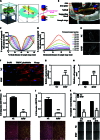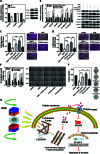Gradient Rotating Magnetic Fields Impairing F-Actin-Related Gene CCDC150 to Inhibit Triple-Negative Breast Cancer Metastasis by Inactivating TGF-β1/SMAD3 Signaling Pathway
- PMID: 38420580
- PMCID: PMC10900498
- DOI: 10.34133/research.0320
Gradient Rotating Magnetic Fields Impairing F-Actin-Related Gene CCDC150 to Inhibit Triple-Negative Breast Cancer Metastasis by Inactivating TGF-β1/SMAD3 Signaling Pathway
Abstract
Triple-negative breast cancer (TNBC) is the most aggressive and lethal malignancy in women, with a lack of effective targeted drugs and treatment techniques. Gradient rotating magnetic field (RMF) is a new technology used in oncology physiotherapy, showing promising clinical applications due to its satisfactory biosafety and the abundant mechanical force stimuli it provides. However, its antitumor effects and underlying molecular mechanisms are not yet clear. We designed two sets of gradient RMF devices for cell culture and animal handling. Gradient RMF exposure had a notable impact on the F-actin arrangement of MDA-MB-231, BT-549, and MDA-MB-468 cells, inhibiting cell migration and invasion. A potential cytoskeleton F-actin-associated gene, CCDC150, was found to be enriched in clinical TNBC tumors and cells. CCDC150 negatively correlated with the overall survival rate of TNBC patients. CCDC150 promoted TNBC migration and invasion via activation of the transforming growth factor β1 (TGF-β1)/SMAD3 signaling pathway in vitro and in vivo. CCDC150 was also identified as a magnetic field response gene, and it was marked down-regulated after gradient RMF exposure. CCDC150 silencing and gradient RMF exposure both suppressed TNBC tumor growth and liver metastasis. Therefore, gradient RMF exposure may be an effective TNBC treatment, and CCDC150 may emerge as a potential target for TNBC therapy.
Copyright © 2024 Ge Zhang et al.
Conflict of interest statement
Competing interests: The authors declare that they have no competing interests.
Figures






Similar articles
-
Zerumbone suppresses the motility and tumorigenecity of triple negative breast cancer cells via the inhibition of TGF-β1 signaling pathway.Oncotarget. 2016 Jan 12;7(2):1544-58. doi: 10.18632/oncotarget.6441. Oncotarget. 2016. PMID: 26637807 Free PMC article.
-
Urchin-like magnetic nanoparticles loaded with type X collagen siRNA and Stattic to treat triple negative breast cancer under rotating magnetic field like an "enchanted micro-scalpel".Int J Biol Macromol. 2025 Apr;300:140318. doi: 10.1016/j.ijbiomac.2025.140318. Epub 2025 Jan 27. Int J Biol Macromol. 2025. PMID: 39864683
-
Association between transforming growth factor-β1 expression and the clinical features of triple negative breast cancer.Oncol Lett. 2016 Jun;11(6):4040-4044. doi: 10.3892/ol.2016.4497. Epub 2016 Apr 26. Oncol Lett. 2016. PMID: 27313737 Free PMC article.
-
Excellent effects and possible mechanisms of action of a new antibody-drug conjugate against EGFR-positive triple-negative breast cancer.Mil Med Res. 2021 Dec 9;8(1):63. doi: 10.1186/s40779-021-00358-9. Mil Med Res. 2021. PMID: 34879870 Free PMC article.
-
Bruceine D suppresses CAF-promoted TNBC metastasis under TNF-α stimulation by inhibiting Notch1-Jagged1/NF-κB(p65) signaling.Phytomedicine. 2024 Jan;123:154928. doi: 10.1016/j.phymed.2023.154928. Epub 2023 Jun 16. Phytomedicine. 2024. PMID: 38043386
Cited by
-
miR-9-5p/HMMR regulates the tumorigenesis and progression of clear cell renal cell carcinoma through EMT and JAK1/STAT1 signaling pathway.J Transl Med. 2025 Jan 9;23(1):36. doi: 10.1186/s12967-024-05988-w. J Transl Med. 2025. PMID: 39789627 Free PMC article.
-
Exploring Ion Channel Magnetic Pharmacology: Are Magnetic Cues a Viable Alternative to Ion Channel Drugs?Bioessays. 2025 Mar;47(3):e202400200. doi: 10.1002/bies.202400200. Epub 2024 Dec 9. Bioessays. 2025. PMID: 39651810 Free PMC article. Review.
-
Enhanced Effects of Intermittent Fasting by Magnetic Fields in Severe Diabetes.Research (Wash D C). 2024 Sep 5;7:0468. doi: 10.34133/research.0468. eCollection 2024. Research (Wash D C). 2024. PMID: 39238846 Free PMC article.
-
PRDM16 acts as a homeostasis regulation factor to suppress the transition of AKI to CKD via upregulation of eukaryotic initiation factor 6.Cell Mol Life Sci. 2025 Jun 23;82(1):252. doi: 10.1007/s00018-025-05766-x. Cell Mol Life Sci. 2025. PMID: 40551013 Free PMC article.
-
Case Report: Tumor-to-tumor metastasis: a rare case of prostate adenocarcinoma metastasis to lung squamous cell carcinoma in a patient with multiple primary malignancies.Front Oncol. 2025 Jun 9;15:1605846. doi: 10.3389/fonc.2025.1605846. eCollection 2025. Front Oncol. 2025. PMID: 40552270 Free PMC article.
References
-
- Siegel RL, Miller KD, Fuchs HE, Jemal A. Cancer statistics, 2021. CA Cancer J Clin. 2021;71(1):7–33. - PubMed
-
- Perou CM, Sørlie T, Eisen MB, Rijn M, Jeffrey SS, Rees CA, Pollack JR, Ross DT, Johnsen H, Akslen LA, et al. . Molecular portraits of human breast tumours. Nature. 2000;406(6797):747–752. - PubMed
-
- Liu X-L, Zhang G, Yu T-Y, He J-L, Liu J, Chai X-X, Zhao G, Yin D-C, Zhang C-Y. Exosomes deliver lncRNA DARS-AS1 siRNA to inhibit chronic unpredictable mild stress-induced TNBC metastasis. Cancer Lett. 2022;543:215781. - PubMed
-
- Yang C-Q, Liu J, Zhao S-Q, Zhu K, Gong Z-Q, Xu R, Liu H-M, Zhou R-B, Zhao G, Yin D-C, et al. . Recent treatment progress of triple negative breast cancer. Prog Biophys Mol Biol. 2020;151:40–53. - PubMed
LinkOut - more resources
Full Text Sources
Miscellaneous

